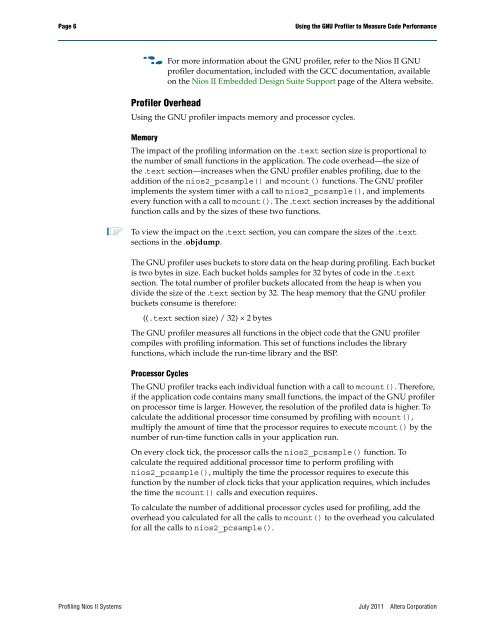Profiling Nios II Systems Application Note 391 - Altera
Profiling Nios II Systems Application Note 391 - Altera
Profiling Nios II Systems Application Note 391 - Altera
Create successful ePaper yourself
Turn your PDF publications into a flip-book with our unique Google optimized e-Paper software.
Page 6 Using the GNU Profiler to Measure Code Performance<br />
f For more information about the GNU profiler, refer to the <strong>Nios</strong> <strong>II</strong> GNU<br />
profiler documentation, included with the GCC documentation, available<br />
on the <strong>Nios</strong> <strong>II</strong> Embedded Design Suite Support page of the <strong>Altera</strong> website.<br />
Profiler Overhead<br />
Using the GNU profiler impacts memory and processor cycles.<br />
Memory<br />
The impact of the profiling information on the .text section size is proportional to<br />
the number of small functions in the application. The code overhead—the size of<br />
the .text section—increases when the GNU profiler enables profiling, due to the<br />
addition of the nios2_pcsample() and mcount() functions. The GNU profiler<br />
implements the system timer with a call to nios2_pcsample(), and implements<br />
every function with a call to mcount(). The .text section increases by the additional<br />
function calls and by the sizes of these two functions.<br />
1 To view the impact on the .text section, you can compare the sizes of the .text<br />
sections in the .objdump.<br />
The GNU profiler uses buckets to store data on the heap during profiling. Each bucket<br />
is two bytes in size. Each bucket holds samples for 32 bytes of code in the .text<br />
section. The total number of profiler buckets allocated from the heap is when you<br />
divide the size of the .text section by 32. The heap memory that the GNU profiler<br />
buckets consume is therefore:<br />
((.text section size) / 32) × 2 bytes<br />
The GNU profiler measures all functions in the object code that the GNU profiler<br />
compiles with profiling information. This set of functions includes the library<br />
functions, which include the run-time library and the BSP.<br />
Processor Cycles<br />
The GNU profiler tracks each individual function with a call to mcount(). Therefore,<br />
if the application code contains many small functions, the impact of the GNU profiler<br />
on processor time is larger. However, the resolution of the profiled data is higher. To<br />
calculate the additional processor time consumed by profiling with mcount(),<br />
multiply the amount of time that the processor requires to execute mcount() by the<br />
number of run-time function calls in your application run.<br />
On every clock tick, the processor calls the nios2_pcsample() function. To<br />
calculate the required additional processor time to perform profiling with<br />
nios2_pcsample(), multiply the time the processor requires to execute this<br />
function by the number of clock ticks that your application requires, which includes<br />
the time the mcount() calls and execution requires.<br />
To calculate the number of additional processor cycles used for profiling, add the<br />
overhead you calculated for all the calls to mcount() to the overhead you calculated<br />
for all the calls to nios2_pcsample().<br />
<strong>Profiling</strong> <strong>Nios</strong> <strong>II</strong> <strong>Systems</strong> July 2011 <strong>Altera</strong> Corporation
















